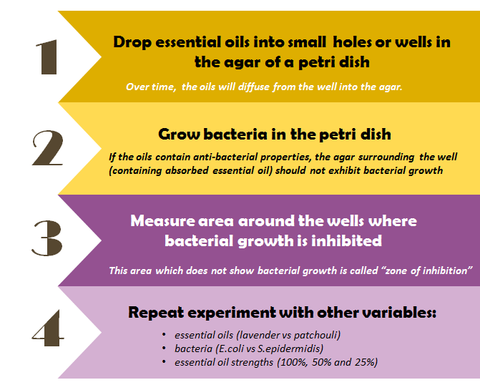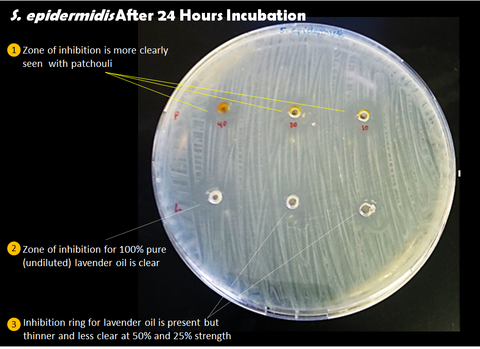July 04, 2016

We take a break from the usual fare of recipes and promos to explore something a little bit different this round.
We often read that essential oils contain anti-bacterial properties. Out of curiosity, one might ask, how true is this and how effective are these oils?
While it is possible to find many articles on the efficacy of essential oils, we decided to do a little science experiment using our own essential oils to see how they fared against bacteria in a petri dish.
We chose patchouli and lavender essential oils, both which are said to have anti-bacterial properties.
For centuries, lavender has been used in herbal remedies such as balms, salves and cosmetics and topical applications to relieve anything from headaches, insomnia to minor wound healing.
Patchouli, which is native to many Asian countries including our own (known as nilam locally), is also a herb used in traditional formulas. In Ayurveda, patchouli has been cited to treat skin and hair problems, and even to assist in snake bites and insect stings.
Experiment Procedure:
The experiment involves dropping essential oils into the agar of a petri dish to see how they prevent or inhibit bacterial growth in the same dish.
Steps:

Experiment Hypothesis:

Results: So, what’s up?
Results with S. epidermidis[1] (gram positive bacteria):

Both lavender and patchouli oils show resistance against s. epidermidis bacteria with patchouli being more effective as it shows a wider and clearer zone of inhibition.

Below is a close up photo showing the inhibition zone rings (circled in white). The wells with the orange rings are patchouli at 100% strength (no dilution) and half strength (20ul of pure essential oil + 20ul of sterile water).

Results with E. coli[2] (gram negative bacteria):

Interestingly, patchouli essential oil did not show any activity against E. coli as there were no inhibition rings formed. Lavender however did show some anti-bacterial activity.

Discussion:
The essential oils at 100% (undiluted) strength do not diffuse well into the agar. After 1 day, there was still a significant amount of oil left in the well. This poor diffusion may have affected the results as the inhibition does not appear proportional to the increase in concentration.
The results where patchouli did not show any activity towards E.coli is consistent with scientific findings that gram-negative bacteria are usually more resistant to the activity of essential oils. This is due to their cell walls which limit or prevent penetration of EOs into the microbial cell[3].
One may also note that essential oils are not typically used in high concentrations such as 100% and 50% strength on a daily basis. Typically, we recommend essential oils to be only 1 - 2% of any oil blend or skin care formulation. Apart from the occasional 100% pure drop on the skin to assist in would healing, we seldom see anything else above 5%. Exposure to high concentrations of essential oils can cause an allergic reaction for some. Hence they may be used to complement health therapies but should not replace one's medication.
Conclusion:
The results show that both lavender and patchouli essential oils have anti-bacterial properties. However, different oils will work better against different bacteria.
It would make sense to mix different types of essential oils together in a blend so that these oils may work concertedly against different types of bacteria. Nevertheless, this would require further experimentation to ensure that all the oils are working synergistically and are not cancelling each other’s effect.
Footer:
[1] S. epidemidis is commonly found as part of the human skin microflora. It causes infections related to indwelling medical devices such as catheters or artificial heart valves
[2] Among some of the infections caused by E.coli are diarrhoea, pneumonia or urinary tract infections.
[3] http://www.ncbi.nlm.nih.gov/pmc/articles/PMC3873673/
Comments will be approved before showing up.
January 25, 2019
Sometimes, essential oils take most of the limelight overshadowing an equally important counterpart in any blend, which is the carrier oils. Carrier oils may be called as such because they "carry" the essential oils but they do have therapeutic properties to offer.
To know more about what oils work best for your therapeutic blend, read on.